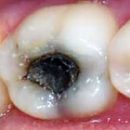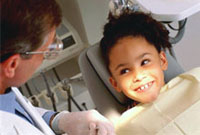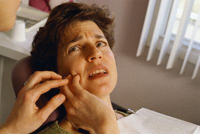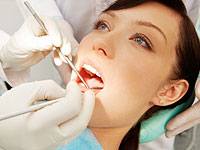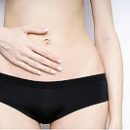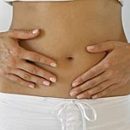What is a dental flare? What is a dental stone? What are the methods of removal of plaque and stone? Answers to the questions you will find in the article.
Content
Toothed and stone
During food, the teeth crushes food, and her small residues inevitably remain in the mouth. On the gums, they do not delay and fall into interdental intervals, very comfortable for this, where they are up to the nearest cleaning of teeth, which is designed to remove them from there and clean the teeth from all over. And if the traditional evening cleaning of the teeth was not either part of the products in the mouth remained untouched?
Then in these areas a healthy microflora of the oral cavity is set, feeling there perfectly - it is warm and damp, food is enough that she still needs? So that it is not disturbed. And if the brush or floss does not touch it, then the microflora is already turning into the macroflora, forming a raid on the teeth, which consists of 95% of the flora and fauna, and the remaining 5% - no matter what. In this case, the microflora turns from the normal (natural for the body) into the pathological (harmful influencing on the body) not only because of its large number, but also changing in its structure and composition, affecting the teeth and the gums is not very good, causing caries And paradontitis.
In addition, the surface of the dental plaque is not smooth, but rough, which improves the adhesion to it. And the further, the more.
When the dental flare is a week and more, it becomes more dense and turns into a dental stone, which is no longer a toothbrush or floss.
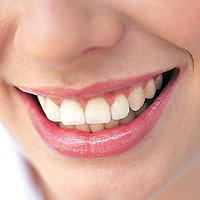 As a tooth stone and raid affect the life of a person? The appearance becomes so-so, the smell of mouth can appear, the risk of caries formation increases, especially if there are seals, there is inflammation of the gums, which leads to paradontitis and teeth mobility.
As a tooth stone and raid affect the life of a person? The appearance becomes so-so, the smell of mouth can appear, the risk of caries formation increases, especially if there are seals, there is inflammation of the gums, which leads to paradontitis and teeth mobility.
Does the tooth stone affect the teeth? The microbial component of the dental stone and the raid (and this, we recall, 95%) in the process of its livelihoods form an acid that destructively affects the enamel of the tooth. In the oral cavity, by the way, alkaline medium, and it would have to neutralize all acidity. I would be happy, but she bothers again the same blooming and tooth stone. She can not penetrate them to the teeth.
Conclusion: the dental flare and the dented stone contributes to the occurrence of caries. And to prevent its appearance, you need to remove the dental stone and dental. Paste for removing the dental stone - one of the methods.
Is the dental plaque affect the gums? Sure! First, it affects it mechanically, especially if Doros is to the dental stone. A chronic injury leads to inflammation of the gums. But we remember that the dented stone consists of a pathological flora. How does it affect the gum? This will already be, secondly: the body is arranged so that it seeks to remove everything too much, including microbes, sending special blood cells to their destruction. But in the region of inflammation of the mucous membrane, the surface layer is disturbed, designed to protect and block the path of infection, so the flora easily falls into the inflamed gum, soaking it through. And blood cells, attacking the microbes, beat not only them, but also the gum, in which they are located. And this again enhances the inflammation of the gums, and it is under the onslaught of the toothaper, plaque, flora and its own blood cells retreats and retreats, when the roots of the teeth, causing the bone atrophy and increasing the mobility of the teeth.
This will be briefly described the paradontitis, which is more often starting with a banal dental plaque, and how it ends - ask the owners of removable prostheses.
How to live on? With dental flare or without solving you. And if you have not spoiled to the phone to call your dentist, read on how the dental removal and plaque.
Modern methods of getting rid of the dental stone
Previously, removed the dented stone with special hooks. Now this method is used extremely rare. Not very he is pleasant, and most importantly, it does not give full cleaning from the dental stone.
Instead, came the method of removal of a toothache ultrasound. The special device generates ultrasound fluctuations, due to which removable nozzles carefully clean the surface of the tooth, not traumating it. Ultrasound dental removal takes place not only due to the touch of the tooth surface with the nozzle, but also due to the effect of cavitation - strong fluid curvature. At the same time, it is not necessary to touch the dental, enough for the nozzle is near him. Due to cavitation, the tooth stone will disappear from the surface of the tooth. If the dental is very dense, then a sufficiently light touch to it by the nozzle, and it will bounce. Strong pressure should not be, because at the same time ultrasonic oscillations will decrease, and the removal of the dental will be like with hooks.
The effect of cavitation is also useful in the fact that when removing the tartar, the oxygen is released from water, which disinfects the processed area, which will agree, is quite important. In addition, there is a mechanical cleansing of the surface of the root and gums. Removing the tootham occurs completely, without a residue.
Dental removal is sometimes difficult to high density of dental stone. Softening the dented stone allow special preparations, after which the dental removal will be held much easier and faster.
After ultrasonic dental removal of teeth polishing. Why it is necessary? To the surface of the teeth is extremely clean and, most importantly, smooth.
How much does the dental removal cost? Depending on the clinic where treatment is undergoing, but we must understand that health is priceless.
And a painful dental removal procedure?
I do not want to banal, but it is absolutely painless. Pressure on the tooth when removing the dental stone is minimal - just to touch the stone and only. Therefore, this is a completely painless procedure. Only a small sensitivity to cool water, which is washes tooth. This can be easily avoided - use warm water. Tell me about this hygienist - he will warm her. So simple. As a last resort, you can make anesthesia. But believe me, our experience - such cases can be counted on your fingers.
Is there harm from the procedure
Question: harmful or not washing the car, making a manicure? The answer is most likely no. Also harmless tooth removal for pregnancy. If it is harmful to do it, the nails will grow again, and the car can be changed. With teeth a little more complicated - they do not grow, and it is not easy to change them. Try to understand whether there is no harm when removing a toothache or how to avoid it. About harmfulness It is usually said that when removing a dental, enamel felt, the teeth are scratched, that the dental flight will still appear.
Apply scratching tooth possible with rough work with manual hooks. With a careful removal of the tattime ultrasound, it is excluded. First, nozzles are not so sharp. Secondly, with a dense contact of the nozzle to the tooth, ultrasound fluctuations stop.
Polishing formulations for removing the toothache and final polishing are largely similar to some dental pastes. Therefore, their use is completely safe for enamel. As they say: and the water is sharpened - you can harm anything. Competent removal of the dental stone and the plaque does not harm the teeth. The benefits of these procedures are obvious - preventing the occurrence of caries and diseases of the paradont (paradontosis and paradantitis).

